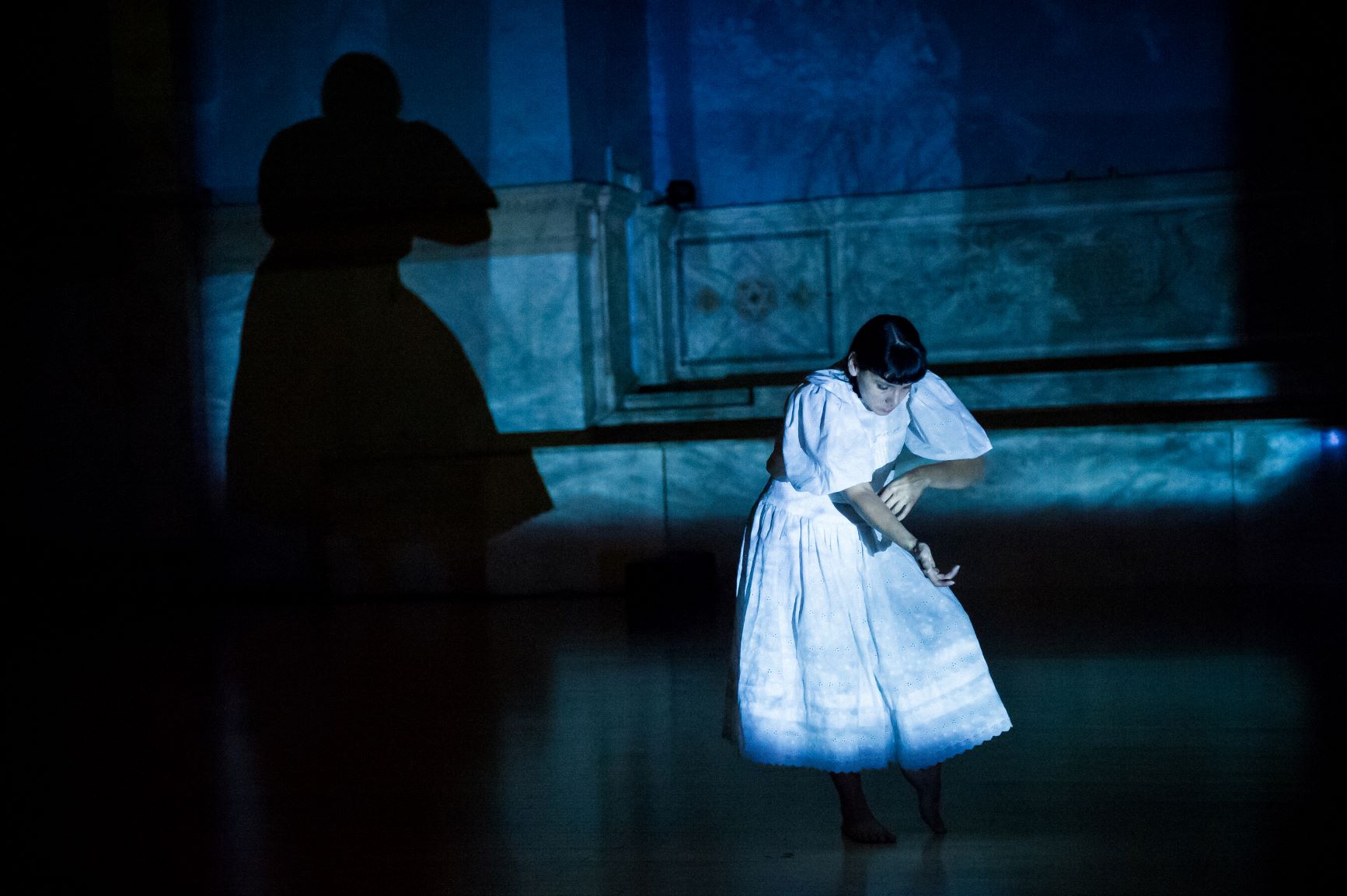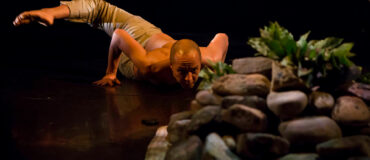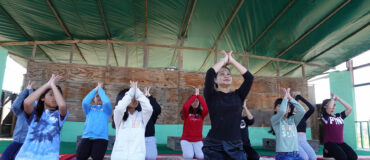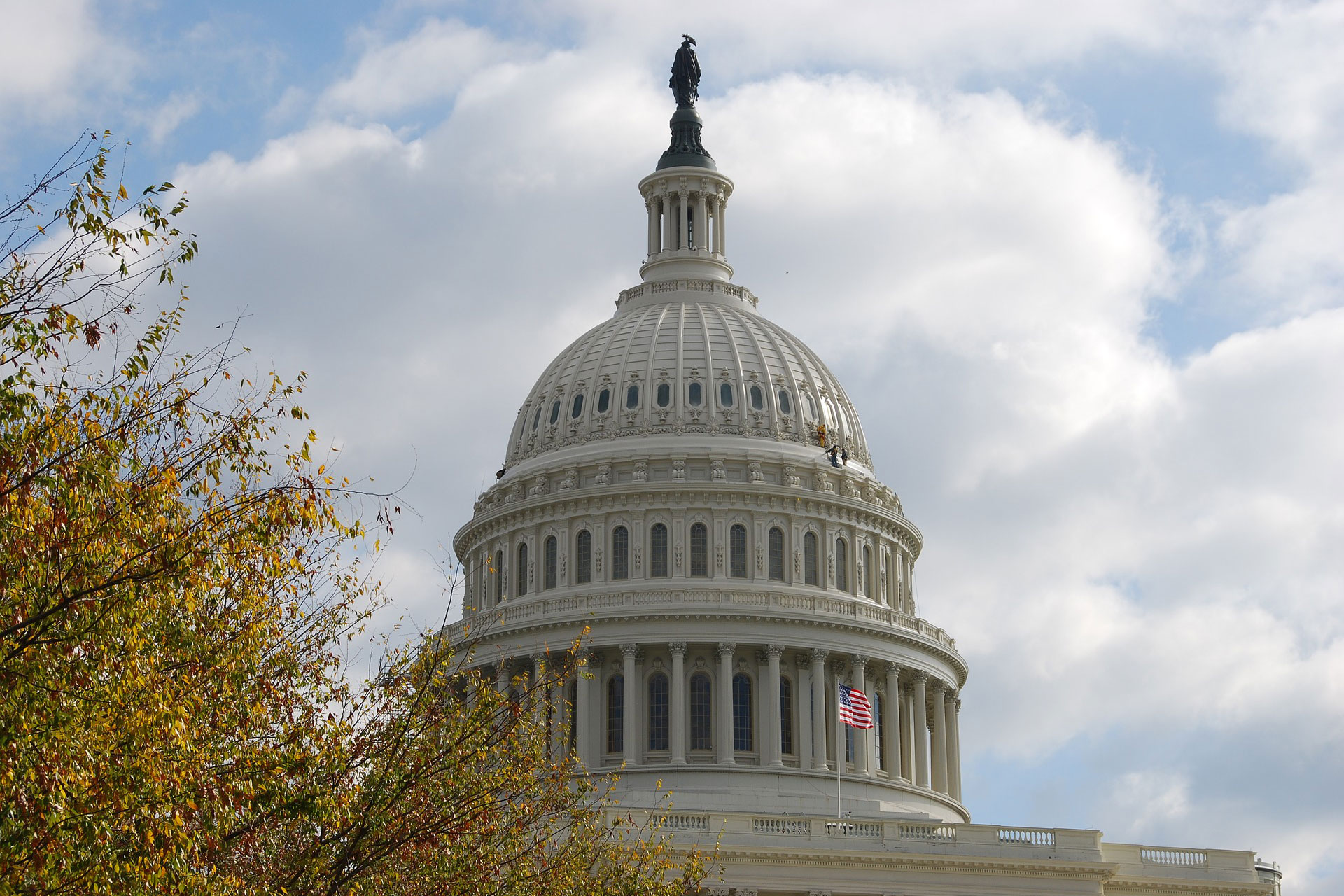Native Dance Now: Body and Spirit
Tony Duncan, Rosy Simas, and Qacung Yufrican
By Lulani Arquette
Editor’s note: This article is one of 11 in a series examining the creative work of 31 dance artists funded by Dance/USA Fellowship to Artists, generously supported by the Doris Duke Charitable Foundation. These artists’ practices are embedded in social change as they work in multiple dance forms in communities across the country.

Clad in a sealskin parka, Qacung Yufrican dances along the shore of Aak’w Bay, Alaska. Dance is central to Yup’ik spiritual and social practice. Christian missionaries banned much Inuit dance in the late 19th century. In the mid-1980s, a cultural revival began to perpetuate Indigenous Alaskan practices. Photo: Konrad Frank
For Native dancers, the physical body is not only their central instrument for expression, it is the literal vessel of their ancestral genealogy, coded in their DNA. When the body is mobilized through specific movement, song, and dance to carry that history and those stories forward, both performers and viewers are enlivened. Put simply, we feel belonging and connection.
Native dance helps us to tell our stories and express appreciation for all of our blessings. Ritual and protocol help inspire the spirit, and allow us to give thanks for the bounty of nature and the Gods, or honor an ancestor — human or animal. Whether on the Arizona desert near Salt River, the urban streets of Minneapolis, the frozen tundra of Alaska, in numerous geographies across the nation or internationally, these artists perform, choreograph, and teach to keep their cultures alive.

As a five year old,Tony Duncan learned hoop dancing from his father. Originally a healing dance of the Taos Pueblo of New Mexico, today it’s danced across tribes at social occasions and powwows. Duncan displays how the hoops form images and shapes from nature. Photo: Esther Costello
As multi-disciplinary artists, Tony Duncan, Rosy Simas, and Qacung Yufrican (aka Stephen Blanchett) practice in various genres of dance, music, and performative presentation. Each has chosen a distinct path to activate cultural truth and social justice. All are committed to life-long learning and disciplined research related to their artistic practice. They share the value of mentoring and working with others, whether with youths, members of their families and communities, or other artists during co-creation. All three express interest in how their performing and teaching can address needed healing for their respective communities and audiences.
Qacung Yufrican grew up in Bethel and Anchorage, Alaska, son of a Yup’ik mother and African-American father. The greatest influence on his cultural dance and artistic expression is his Yup’ik community and traditional upbringing. Qacung is part of the award-winning tribal funk/world music band Pamyua and the current art education director at Juneau Arts and Humanities Council.
Rosy Simas is a transdisciplinary artist, teacher, and presenting choreographer who resides in Minneapolis and is Haudenosaunee, enrolled Seneca, Heron Clan. She states: “The culture, history, and identity stored in my body is the underpinning of all my artwork.” Simas has won numerous fellowships and in 2019 co-edited the first Indigenous issue of the Movement Research Performance Journal, Sovereign Movements, issue 52/53.
Tony Duncan’s cultural and arts practice began with hoop dance training, at age five, under the tutelage of his San Carlos Apache father. His mother is a champion fancy dancer from the Mandan Hidatsa Arikara Nation of North Dakota. A five-time World Champion Hoop Dancer, recording flute player, and singer, he founded his company, Tony Duncan Productions, at age 18.
TONY DUNCAN
In urban and rural communities across the country, Indigenous dance is an integral part of cultural life that gives voice to often unheard stories. With Duncan, dance has passed through multiple generations of his family lineage. The cultural knowledge carries greater importance and precedes dance technique. Duncan explains that his father taught him about the Apache concept Bah-seh’ to help him understand the significance of the hoops used in the hoop dance. Bah-seh’ is an action verb that embodies changing and movement; it means the continuity of life.
Duncan describes the dance’s progression from east to south to west to north, reflecting the four seasons — spring, summer, fall, and winter. With each addition of a hoop, these seasons and cardinal directions also recall the progression from life’s beginnings, to adolescence, maturity, and, finally, elderhood — a time of storytelling, sharing and snowfall at the height of winter. The dance doesn’t end there: The cycle completes, returning to the east, to repeat. He says, “The way I was taught was not as dancing steps. The hoop dance was first introduced to me as a teaching, as philosophy, a way of thinking. It is an honoring dance used to pray, to heal.”

A champion hoop dancer, Duncan shares stories of creation, warriors and tricksters integral to Native American culture. Through dances and songs, music and stories, he passes cultural wisdom on to the next generation, instilling values and ancestral practices in young people. Courtesy: Tony Duncan
Duncan notes how this method of learning is circular and continuous, not linear like many dance practices. The four stages of Bah-seh’ lay the foundation for all aspects of the dance — reflected in the body’s turns, stomping footwork in all four directions, and the skilled use of numerous linking hoops. He has used up to 50 hoops at a time. The hoops remind us to maintain connections and balance within ourselves: “When our eating is off balance, our body tells us …. It is a lifelong effort to find balance for ourselves.” This resonated with me as I thought of my own Native Hawaiian culture and the importance of lokahi, a cultural value that focuses on maintaining balance and harmony in our harried lives. Duncan credits Tony White Cloud of the Jemez Pueblo with bringing the hoop dance to the public eye in the 1930s and raising awareness of the dance style. Through Bah-seh’ and these seasons of dance, Duncan and Native peoples pray, heal, and celebrate.
ROSY SIMAS
Simas’s Seneca Nation dances and traditional ceremonies are not for public viewing. For her, cultural responsibility is important and complicated. She refers to herself as a contemporary dancemaker who does abstract work; she avoids creating pieces that feed a desire for recognizable Indigenous signifiers — costumes, images, texts — so the audience understands it as Native. Simas has established her own protocol of asking permission and interacting with her home community, as she feels a responsibility to her ancestors, family, and her practice.

She spoke about the waves of settler colonialism that happened, east to west, in North America. Coming from a northeast tribe, she reflects on the treaty negotiations and interactions with the Dutch colonists: “Our diplomacy goes far back …. We have centuries of protocol. Seneca historically have been very intentional in not sharing sensitive information with outside people.”
This Haudenosaunee history sparks her activism. Simas tells me her creative process includes research into her culture and community. Her current work contemplates healing and grieving and is inspired by the philosophy of the Great Law of Peace, which brought together the Iroquois Confederacy. In 2019, she travelled back east to attend a reading of the Great Law. That physical act of being present greatly affected her new work.

Simas is Haudenosaunee, Seneca, Heron clan. She grew up dancing around a drum, stating, “The living architecture of my body is formed by movements deeply connected to the earth. Culture, history, and identity stored in my body are the underpinning of all my work.” Photo: Tim Rummelhoff
Simas is uninterested in commodifying her work to imbue learning or pure consumption so that funders, presenters, or audiences can check off a “Native box.” She creates intentional environments and hopes audiences will commit to being in that space together, even if they don’t quite understand what they are experiencing. Her performances often include movement, sculpture, sound, and film, and intermingle performance with audiences, both indoors and outdoors. The 2019 piece WEave:HERE was a 60-minute processional performance that traversed two blocks down the Native Cultural Corridor in Minneapolis into installations by Ojibwe artists Heid E. Erdrich and Jonathan Thunder.
Her work provokes viewers to pay attention, a rarity in these times. As a practicing meditator, I would describe it as being coaxed into a Zen-like state or Native mindset that is not driven by western concepts of time. This shift in sensory perception lets one’s senses intermingle — hearing the movement, seeing the sound, feeling the story.
QACUNG YUFRICAN
In some Native cultures dance can be playful and humorous. Yufrican spoke about one of his favorite dances and songs, called “Anguwartugalria,” which translates to “I am paddling.” It’s about a seal hunt and is meant to make people laugh. Taught to him by Benny Snowball, his first drum and dance teacher, this simple children’s song and dance encourages improvisation, allowing the performers to inject their own personality. Some of Qacung’s favorite moments and memories when creating and performing new work encourage spontaneity and humor: “If you can make each other [drummers and dancers] lose it, have them break their performance role, that is gold.” Getting someone to laugh provides a candid glimpse into Yup’ik culture. “It is beautiful when we can show that humor, share our love of laughter.”

Qacung’s mother, Marie Arnaq Meade, didn’t grow up with traditional Inuit cultural dances. She learned those dances in her 30s. But she ensured her children knew their Indiginous heritage. Qacung and family perform a Yup’ik dance honoring Meade’s contributions to Yup’ik culture. They hold tegumiat, traditional mens dance fans. Courtesy: Qacung Yufrican
Joe Chief Jr., from Qacung’s hometown, was a well-known dancer influencing him on his preferred style of dance and performance. Qacung had never seen someone so energetic and full of joyous life; Joe Chief Jr. was the master of facial expression and a comedic, stylized type of dance that mimics Alaskan traditional masks. As an accomplished dancer, Qacung exudes energy, excitement, and good feelings, much like Duncan, and, of course, his mentor Joe Chief Jr. After all, Qacung’s goal is to make people happy.
He discusses how the impacts of colonization cause cultural shame, intolerance, and racial inequities. He believes we need to begin with the youth to instill pride. A story about his maternal grandma powerfully demonstrates that healing can come at any age. His mother was a traditional dancer, but his grandmother refused to watch her daughter dance because, based on influences of missionaries, she thought the dances were evil. Many Natives of that generation held those beliefs and almost every Native person can cite a similar experience within their family. When his grandmother lived in a senior center, people would ask about her dancing family members, but she wouldn’t discuss the topic. Yet after hearing so much about her grandson’s performances, she decided to see him dance. Qacung and his brother arranged for a performance at the Camai Dance Festival and got her a spot right up front. As they began dancing, the look of disapproval on her face softened. By the end, she was completely smiling and even dancing! Qacung shared how gratifying it was to see her change. Soon after, his grandmother told him, “I can see that what you do is not evil. You make people happy; you make people smile.” She gave him her blessing.
RECIRPOCITY AND CONNECTIONS TO LINEAGE
In most Indigenous cultures, artists feel an intrinsic responsibility for what they do, whether they work in disciplines rooted in cultural practice; new evolutions of that cultural dance, like Duncan and Yufrican; or new frontiers in performance and choreography, like Simas. For these three artists, creative discipline derives from a deep-seated commitment to their cultures and communities.
We all strive to understand what came before us — our ancestry and familial heritage. Reclaiming our culture and language in modern times is an act of decolonization and Indigenous resilience in the face of a difficult past. What distinguishes Native artists in the United States is our diversity and this unique history of settler colonialism and theft of homelands that have rendered multigenerational scars. With that constant pull to return “home” to that which is safe and familiar, if not literally, at least in our minds, we acknowledge a greater cosmic order that values reciprocal relationships and the interconnectivity of all things.
Rosy’s work with her Seneca community ties her to a sense of peacemaking, diplomacy, and reciprocity. She explained that her people practice living in balance with the natural world — not taking more than they need. I can’t help thinking how important finding balance is in these chaotic and polarized times.
In choosing new projects, Tony goes to family: his father first, then his wife. Both tell him if they think he’s going too far. His wife, Violet, organizes his projects and he dances with his kids outside, to get exercise, have fun, and get them off electronic devices. Before he starts to dance, he prays and says four times in Apache language: “Goo-zhoo’-doo-lelth’,” which means, “May beauty continue.”
Qacung reflects on his creative process and performing, which are flexible and accepting of unpredictability. He finds a special energy in that moment of creation: “We feel our ancestors; we feel the space and place. The body takes over. We don’t know when that is going to happen when we are sitting in the community house doing dances and songs. That perpetuation, that connection with our people and culture, us being in that room, right in that moment, those are our moments, and no one else’s.”
T. Lulani Arquette is the president and CEO of the Native Arts and Cultures Foundation (NACF), a national organization dedicated to advancing equity and Native knowledge with a focus on arts and cultural expression that helps strengthen American Indian, Alaska Native, and Native Hawaiian artists and communities. With offices in the Pacific Northwest, the organization provides support to Native artists, tribal organizations, and communities across the nation. Arquette, a theater performing artist herself with degrees in political science and drama and theater, brings more than 25 years of professional experience steering organizations to their highest creativity and potential, advocating for cultural perpetuation and social change, and catalyzing the creative arts to inspire communities. Her current work is especially focused on how we attend to cultural equity, social justice, leadership, and the environment to build a more compassionate and just nation.
Please visit the artists’ websites: Tony Duncan, Rosy Simas and Qacung Yufrican. Readers may read and print a PDF version of this article here. Readers may visit and share this article on Medium here. Find more information on the DFA Article Series here and more information on Dance/USA Fellowships to artists here.
____
We accept submissions on topics relevant to the field: advocacy, artistic issues, arts policy, community building, development, employment, engagement, touring, and other topics that deal with the business of dance. We cannot publish criticism, single-company season announcements, and single-company or single artist profiles. Additionally, we welcome feedback on articles. If you have a topic that you would like to see addressed or feedback, please contact communications@danceusa.org.
Disclaimer: Opinions expressed in guest posts do not necessarily represent the viewpoints of Dance/USA.






